
For years we’ve wondered: which of the three evolutions of Integra is the fastest?
This review was first published in MOTOR magazine's December 2005 issue.
Two evolutions of Type R and the latest Type S each have their strengths, but which is best and why? First, some background. It started in Australia with the 1999 Honda Integra Type R, model code DC2, and a version that went on sale in Japan in 1995.
Raw, loud, light and mean, its quad round headlights and 141kW 1.8-litre were the only real difference between it and the full-house 149kW Jap spec version. It scored an LSD, Recaros and a Momo steering wheel, a shopping trolley spoiler and a real slant towards pure performance.
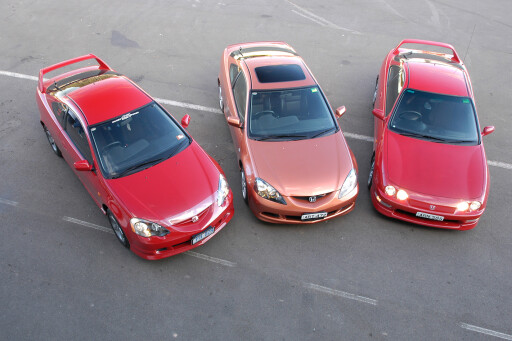 But two years later, the DC5 version of the Aussie Type R diluted its tough guy image. Problem was it was a Type R in name only. It was a fake, a fraud, a phoney and effectively a softer Japanese Type S. Sure, power from a new 2.0-litre bumped up to 147kW, but it was still less power than the Jap spec and it gained weight.
But two years later, the DC5 version of the Aussie Type R diluted its tough guy image. Problem was it was a Type R in name only. It was a fake, a fraud, a phoney and effectively a softer Japanese Type S. Sure, power from a new 2.0-litre bumped up to 147kW, but it was still less power than the Jap spec and it gained weight.
So the Type R/S, as we’ll call it, has bark without bite. Or does it? Redone last year, the DC5 Type S was again the genuine model, Honda rightly realising it should call a spade a Type S. It gained even more weight, but with firmer suspension and a power boost to 154kW, is the Type S better or worse than its predecessors?
Does the evolution from 15- to 16- and then 17-inch wheels have a large effect, and does modern rubber and six years of chassis development make up for the lack of an LSD and extra weight?
All these questions are why we’ve lobbed at Oran Park Raceway’s South Circuit, for a final farewell to ART, our Blaze Orange long-term Integra Type S. But before we bid adieu, we had to find an answer for 0-100km/h, quarter-mile and lap times.
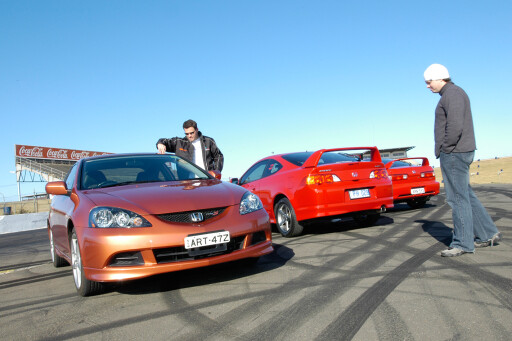 So we enlisted the professional help (and some say he needs it) of John ‘Boz’ Boston, advanced driving instructor, NSW Street Sedan champ and Datsun 1200 tragic.
So we enlisted the professional help (and some say he needs it) of John ‘Boz’ Boston, advanced driving instructor, NSW Street Sedan champ and Datsun 1200 tragic.
Finding earlier examples of Type Rs isn’t just a case of calling a hotline either, so a big thanks to Honda Owners Club members Brad Wood for bringing his immaculate DC2, and Peter Hausknecht for his spotless DC5 Type R. Both are factory standard, low mileage and the perfect representatives of their Types.
Allan Shephard’s Thrifty-sponsored DC2 Type R, modified for GT-P production car racing, also joined us. With semi-slicks, trick suspension and a gutted interior, we’ll see how much faster a real racer can go. So let’s get Typing.
ROUND 1: QUARTER-MILE DRAGS
Type S (DC5): Grip, gearing and power-to-weight ratios is what makes a fast drag car. On Oran Park’s slightly downhill strip, we start with the Type S, possessing the most power and widest tyres.
 Easy to launch with around 5000rpm, it needs a little pedalling to optimise the launch, and needs a shift to third gear around 93km/h and fourth around the 240-metre mark. Well run-in, we manage the best times we’ve seen for ART (well, it is downhill).
Easy to launch with around 5000rpm, it needs a little pedalling to optimise the launch, and needs a shift to third gear around 93km/h and fourth around the 240-metre mark. Well run-in, we manage the best times we’ve seen for ART (well, it is downhill).
0-100km/h: 6.94
0-400m: 14.97 @ 157.2km/h
Type R (DC5): Suspecting it’ll be slowest, we find an incredibly short-geared six-speed that works through the ratios so fast, it’s on the limiter in fourth at 400 metres. It’s a little harder to launch, with care needed to avoid axle tramp, and though the gearbox feels better than the Type S, it’s the top-end that hits.
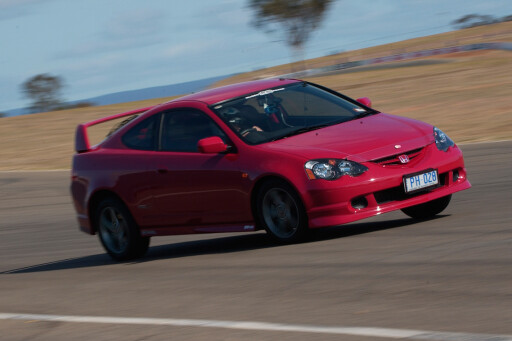 Its times are slower than the Type S by tiny margins, but the Type R/S holds the highest trap speeds – that later proves significant.
Its times are slower than the Type S by tiny margins, but the Type R/S holds the highest trap speeds – that later proves significant.
0-100km/h: 6.97
0-400m: 14.99 @ 158.7km/h
Type R (DC2): We saved the theoretical best for last, but despite the narrow rubber, the DC2 Type R scoffed at the newer models, laying down a 0-100km/h time two-tenths faster, and still a tenth ahead at 400 metres.
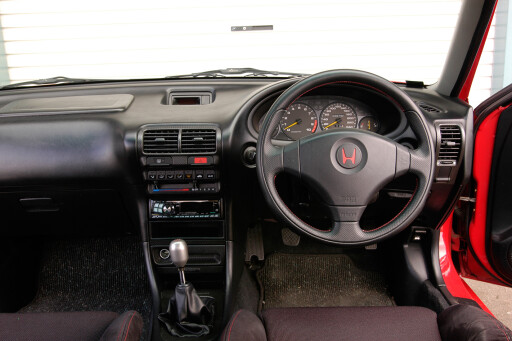 What the figures don’t tell is how much noisier the DC2 is, the thinner windscreen and minimal sound deadening making the cabin roar, the wail of 8500rpm cutting right through you and tingling every sense.
What the figures don’t tell is how much noisier the DC2 is, the thinner windscreen and minimal sound deadening making the cabin roar, the wail of 8500rpm cutting right through you and tingling every sense.
The light weight of the original makes it the easiest and fastest to get off the line, and it’s able to hold the lead all the way despite its power and torque deficit. Compared to the other two more sanitised versions, the DC2 offers a buzz like a race car and the fastest factory times here.
0-100km/h: 6.79
0-400m: 14.88 @ 156.8km/h
ROUND 2: LAPS
Boston had five laps around Oran Park’s undulating 1.96km South Circuit to set each car’s fastest time. Tyre pressures were checked and all set around 37-35psi front/rear, with the VBox recording all data.
Type S (DC5): Pulling 169km/h down the main straight, Boz says: “It has good mid-range and good top-end pull. It’s squirmy under brakes, and the rear-end moves around, but it’s really controllable. I’m just using third and fourth gears, and the gearing is spot-on around here, and there’s good power down.”
 Oran Park is clearly better suited to the Type S than other tracks we’ve tried, with good grip from the 17-inch Bridgestone 215/45 RE050s. “But the seats are awful – I’m sliding around all over the place!” Still, a lap time of 53.1 is very sharp.
Oran Park is clearly better suited to the Type S than other tracks we’ve tried, with good grip from the 17-inch Bridgestone 215/45 RE050s. “But the seats are awful – I’m sliding around all over the place!” Still, a lap time of 53.1 is very sharp.
Fastest lap: 53.10
Top speed: 169.5km/h
Type R (DC5): With Peter standing by like a nervous Dad, Boz blasts down Oran’s straight. It outspeeds the Type S by 0.2km/h but is the only car to need fifth gear, and also fourth gear going into turn four (Suttons). It’s more stable under brakes, but where it suffers most is mid-corner speed.
 Says Boz: “It feels a little more understeery compared to the S, and that’s why it’s losing speed on turn-in. The seats are a lot more supportive than the S. The gearbox is really sweet. It actually feels like it has more torque than the S but I would have sworn it was slower up top.
Says Boz: “It feels a little more understeery compared to the S, and that’s why it’s losing speed on turn-in. The seats are a lot more supportive than the S. The gearbox is really sweet. It actually feels like it has more torque than the S but I would have sworn it was slower up top.
Impressive!” Which is why the biggest surprise is to see the slight amount it loses in the corners from the 16-inch 205/55 Bridgestone RE030s; it makes up for it in gearing and power down the straights. And it smashes any of the ‘slowest Type’ titles away to be the fastest road car here.
Fastest lap: 53.05
Top speed: 169.7km/h
Type R (DC2): Quickest at the drags, the DC2 tears down the straight in fourth gear, and though it’s the only one to tip over the 170km/h mark, the difference between all three is just 0.6km/h! The 195/50 x 15 Toyo Proxes T1R tyres may be the smallest, but they do a damn fine job.
According to Boz, “It actually feels like it has more grip, you can get on the power earlier than the other two with maybe a little more mid-range power and mid-corner speed. I’m quite surprised they’re 15s, as it was nearly as responsive as the Type S [on 17s].
.jpg ) The gear ratios are perfect and I thought it was going to be more taily, but it’s better than the Type S! The Recaros are just brilliant: grippy and supportive and they’re mounted lower than [the slightly wider Recaros] in the Type R/S.”
The gear ratios are perfect and I thought it was going to be more taily, but it’s better than the Type S! The Recaros are just brilliant: grippy and supportive and they’re mounted lower than [the slightly wider Recaros] in the Type R/S.”
So the Type R makes up for its power and engine capacity losses by the simple advantage of power-to-weight. Its light kilos help acceleration, cornering speed and punch out of the corners, emphasising that less weight is often more important than more power.
Fastest lap: 53.09
Top speed: 170.1km/h
RESULTS
The verdict is simple: there’s barely a damn thing to separate all three versions of the Integra Type Rs and Type S! That three models with such evolution and mechanical improvements can all lap within one-half-of a tenth of each other (that’s 0.05 seconds!) is incredible.
Being this close is as much about the driver as car. Sure, the drags result is clear: the first Type R uses its light weight and LSD to power ahead, but the Type R/S gear ratios and a fraction more power makes it dead-even with the more powerful (and more torque) Type S.
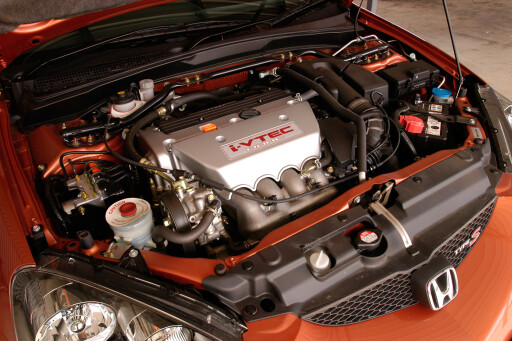 Around the track, the Type R/S surprised with its top-end power, and the Type S proves at least two things: that the evolution of the ‘softer’ model can keep pace with the hard-core original, and that true Type R fans are really missing out on the full-house Jap model. But we want a winner.
Around the track, the Type R/S surprised with its top-end power, and the Type S proves at least two things: that the evolution of the ‘softer’ model can keep pace with the hard-core original, and that true Type R fans are really missing out on the full-house Jap model. But we want a winner.
So for its purity, its low-mounted Recaros, its LSD, and the fact it’s fastest at the drags and as fast around the track, plus its price on the used car market, the original DC2 Type R gets our vote as the original and the best.
| Honda Integra Type S (DC5) specs: | Honda Integra Type R (DC5) specs: | Honda Integra Type R (DC2) specs: | |
| Engine | 2.0-litre, DOHC, 16-valve VTEC four-cylinder | 2.0-litre, DOHC, 16-valve VTEC four-cylinder | 1.8-litre, DOHC, 16-valve VTEC four-cylinder |
| Power | 154kW @ 7800rpm | 147kW @ 7400rpm | 141kW @ 7900rpm |
| Torque | 194Nm @ 7000rpm | 192Nm @ 6000rpm | 178Nm @ 6300rpm |
| Weight | 1230kg | 1160kg | 1087kg |
| Weight to power | 7.9kg/kW | 7.9kg/kW | 7.7kg/kW |
| Wheels/tyres | 17x6.5; 215/45 Bridgestone Potenza RE050 | 16x6.0; 205/55 Bridgestone RE030 | 15x6.0; 195/50 Toyo Proxes T1R (std B’stone RE010) |
| Brakes | 300mm vented discs, two-piston calipers (f); 260mm solid discs, single-piston calipers (r) | 300mm vented discs, two-piston calipers (f); 260mm solid discs, single-piston calipers (r) | 282mm vented discs, 260mm solid discs, single-piston callipers (r) |
Type R DC2 Thrifty racer
So how much better is a race version? Allan Shephard’s 1170kg Thrifty DC2 bags up its 205/50 x 15 Yokohama Advan A048s and belts out acceleration times half-a-second faster than the roadies!

Shephard reinforces that his wheel alignment settings sacrifices straight-line stability for better turn-in. The result is a lap time more than two seconds faster than the road cars. That’s impressive!
0-100km/h: 6.45
0-400m: 14.53 @ 159.2km/h
Lap time: 50.90
Top speed: 174.7km/h
DC2 the next step
Showing another phase of Type R tuning, Matthew Dooley (aka Chuck) has fitted Toyo Trampio R881 195/55x16 semi-slicks, harder brake pads and high-temp fluid, plus a full extractor and exhaust system to his DC2.
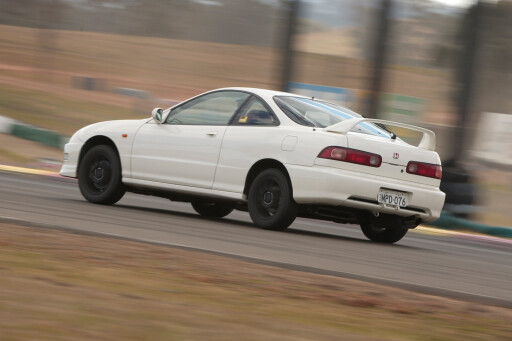 With just one lap before our track time expired, though Boz didn’t drive, Matthew’s 53.10 lap time did record 171.6km/h down the straight and corner speeds and acceleration very close to the race car. We’d be surprised if it couldn’t manage mid 51s.
With just one lap before our track time expired, though Boz didn’t drive, Matthew’s 53.10 lap time did record 171.6km/h down the straight and corner speeds and acceleration very close to the race car. We’d be surprised if it couldn’t manage mid 51s.

COMMENTS